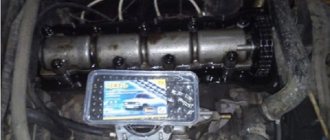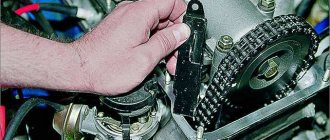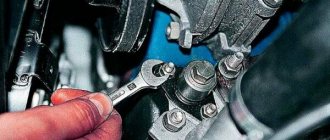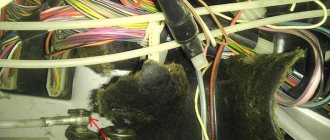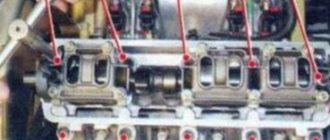Timing chain tension
If a loud knocking and grinding noise begins to be heard from under the hood of a VAZ 2106 when starting the engine, the most likely reason for this is a failure of the timing chain tensioner shoe.
As a result, the chain sags and begins to hit the cylinder block cover. The tensioner shoe should be replaced promptly. Otherwise, the timing chain may break and the engine will be seriously damaged. The tension shoe is designed to reduce the amplitude of timing chain vibrations when starting the engine. If these vibrations are not suppressed in a timely manner, the crankshaft and timing shaft, connected by the timing chain, will rotate in different phases. As a result, the synchronous operation of the cylinders will be disrupted. This, in turn, will lead to failures in engine operation and its inadequate response to pressing the accelerator pedal, as well as to a sharp increase in fuel consumption.
The timing chain tensioning system of the VAZ 2106 consists of three elements:
- timing chain tensioner shoe;
- tensioner oil fitting;
- timing chain damper.
Each of these elements has its own purpose.
- The timing chain tensioner shoe is a curved steel plate that periodically puts pressure on the timing chain and reduces the amplitude of its vibrations. The surface of the shoe in contact with the chain is coated with a particularly durable polymer material. This material is quite durable, but when it wears out, loud knocking noises from the chain beating against the cylinder block begin to be heard from under the hood.
- The tensioner oil fitting is the device that the shoe is attached to. Because of this fitting, the shoe extends and puts pressure on the timing chain if it becomes loose, and retracts when the chain is tightened. A high pressure oil line with an oil pressure sensor is connected to the fitting. If the chain slackens when starting the engine, the sensor detects a decrease in pressure in the line. This reduction is compensated by the supply of an additional portion of oil, which puts pressure on the piston in the fitting. As a result, the shoe extends and dampens chain vibration.
First, a mechanical system was developed in which the tension shoe was driven by the elastic force of a conventional spring. Since the springs with shoes pressed continuously on the chain, such a system quickly wore out.
The mechanical one has been replaced by a hydraulic calming system, which is used on the VAZ 2106. Here, the movement of the shoe is ensured by a special hydraulic fitting, into which oil is supplied as needed. Such a system lasts much longer, and the driver has noticeably fewer problems with its maintenance.
To replace the fitting and tension shoe you will need:
- a new tension shoe for the VAZ 2106 (costs about 300 rubles);
- set of socket wrenches;
- ratchet;
- set of open-end wrenches;
- steel wire with a diameter of 2 mm and a length of 35 cm;
- flat blade screwdriver.
Before starting work, it is necessary to remove the air filter - without dismantling it it is impossible to get to the tensioner shoe. The work is performed in the following order.
- Use a 14mm socket to unscrew the five air filter mounting bolts. The filter is removed.
To tension the VAZ 2106 timing chain you will need:
- set of open-end wrenches;
- flat screwdriver;
- socket wrench 19.
Procedure
The VAZ 2106 timing chain is tensioned as follows.
- Using the above algorithm, the air filter, fitting and tensioner shoe are removed.
- A 19 mm spanner is put on the crankshaft nut.
- Using a wrench, the shaft is turned clockwise until the chain tension under and above the crankshaft is the same. The tension level is checked manually. To fully tension the chain, the crankshaft must make at least two full revolutions.
Step-by-step instruction
Before starting work on tensioning the chain, the car must be placed in a comfortable position. Place the gearshift knob in the neutral position and secure the wheels so that the car does not roll during the procedure.
Tools
To carry out the work, the following tools are required:
- set of socket wrenches;
- set of heads;
- pliers;
- screwdriver;
- hammer.
Before starting work, you should make a visual inspection of the chain drive. If mechanical damage is found to the tension roller, shoe, guide, sprockets or chain, the defective parts must be replaced.
Stages
The sequence of work when tensioning the chain both in an engine with an injector and with a carburetor consists of the following steps:
- To access the timing chain, it is necessary to remove the protective cover by unscrewing the mounting bolts that hold it in place.
If they are not set correctly, the valve timing will be disrupted. As soon as you need to exert a lot of force, you need to stop and hold the shaft from turning with a key. It is in this position that the tension will be sufficient.
Sometimes tensioning is impossible because the chain stretches over time and the plunger is no longer long enough to make the adjustment. If you do not plan to change the product, then for temporary driving you can increase the tensioner rod, for example, by attaching a bushing to the end of the rod, with which the air filter is attached. But still, a worn-out product must be replaced in the near future.
Required tools:
- keys from the standard set;
- universal pulley clamp;
- special key for “36”;
- empty, clean container for draining antifreeze.
Replacing the timing chain on a VAZ 2106 as well as a damper, tensioner shoe, and sprockets
- Remove the air filter housing from the carburetor.
How to replace the timing chain on a VAZ 2106 with your own hands
- Unscrew 3 nuts with a “10” wrench, and 4 nuts with a “8” wrench. All actions must be performed carefully so that nothing falls on the carburetor. If this is neglected, it will be necessary to remove this unit, possibly the intake manifold.
Do-it-yourself replacement of the timing chain on a VAZ 2106
- Remove the distributor cap and remove the pipe used to supply fuel.
- Using a “10” wrench, remove the 8 nuts securing the valve cover and remove the washers with plates.
- Disconnect the choke cable and throttle valve drive.
- Remove the valve cover with gasket (ideally it is better to replace it).
Changing the timing chain on a VAZ 2106
- Remove the protection from below, drain the antifreeze into the container that was prepared initially.
- Using a wrench set to “19”, loosen the generator mounting nut.
- Loosen the clamp of the lower water pump pipe and remove it.
How to replace the timing chain on a VAZ 2106, stabilizer, tensioner shoe, and sprockets on your own
- Turn off the power to the fan, as well as the power to the temperature sensor on the radiator.
- Remove the radiator with pipes and thermostat.
- Loosen the generator chain tensioner nut. Use a pry bar to move it forward.
Read more: Replacing the air filter in a Kia Spectra car step-by-step instructions
Replacing the timing chain on a VAZ 2106 with your own hands
- Disconnect the VAZ 2106 alternator belt.
- Using the “36” key, turn the crankshaft by the pulley until the marks of the cover and pulley, the sprocket and the casting in the camshaft bed coincide.
Timing chain VAZ 2106
Also check out
Timing chain VAZ 2106
- Unscrew the “36” nut securing the crankshaft pulley. Use a special key to lock the pulley and unscrew it. If there is no special key, you need to engage fifth gear, depress the brake pedal, and unscrew it using the key.
Replacing the timing chain on a VAZ 2106, as well as a damper, tensioner shoe, and sprockets
- Remove the pulley. Unscrew 6 bolts and 3 nuts with a “10” wrench, then 3 more bolts of the camshaft drive cover, remove the cover.
We change the timing chain on a VAZ 2106 damper, tensioner shoe, and sprockets with our own hands
- Unscrew the 2 nuts securing the chain tensioner and remove it.
The photos show an automatic tensioner.
- Loosen the bolt that secures the camshaft sprocket, after which you can remove it. The position for centering is worth remembering, or better yet, marking.
In the photo you can see the result.
- A fuse to prevent the circuit from jumping.
- Fastening the timing chain tensioner shoe.
- Crankshaft sprocket.
- Using a “10” key, disconnect the fuse, the tensioner mount, and the bolt that secures the auxiliary drive sprocket.
Replacing the timing chain on a VAZ 2106 at home
- Remove the sprockets and old timing chain. The crankshaft key and the casting on the cylinder block must match.
- Install new sprockets, crankshaft and auxiliary units to the drive. Install a carefully lubricated new chain.
- To prevent the chain from falling down, you need to place some kind of tool under it.
Changing the timing chain of a VAZ 2106 at home - The sprocket is installed in the chain so that the descending branch of the chain is tensioned and all its marks coincide. Next you need to turn the camshaft from right to left and go back behind the crankshaft. Thanks to these actions, the chain is tensioned, and you can check the correct installation of the marks. If the marks do not match, you need to throw the chain over the tooth and then repeat the procedure.
- Return the tensioner to its place and activate it. Tighten all mounting bolts and secure them. Turn the crankshaft 2 turns, make sure that the marks match and that the valves and pistons do not collide.
- Lubricate the crankshaft cover gasket with sealant and install it in place.
- Place the pulley, make sure that the marks match, and tighten it.
- Unscrew the distributor nut to “13”, remove the distributor itself, turn the slider to the contact of the 4th cylinder.
- Return the distributor to its place.
- To complete the procedure for installing a new VAZ 2106 timing chain, be sure to turn on the ignition.
- Reassemble in reverse order and add antifreeze.
- At this point, the replacement of the timing chain on the VAZ 2106 can be considered complete.
When is stretching necessary?
The gas distribution mechanism on the VAZ 2107 injector consists of the following elements:
- intermediate and crankshaft gears;
- camshaft and intermediate shaft;
- rocker;
- sedative;
- intake and exhaust valve;
- tensioner;
- shoe;
- timing chain drive.
The photo shows timing parts.
Thanks to the timing belt, the air-fuel mixture is supplied and exhaust gases are removed. Its operation is carried out using a chain drive or belt. They transmit torque from the crankshaft to the camshaft.
The shafts must be in a certain position. To do this, special marks are placed on the crankshaft pulley and the camshaft sprocket, which must be set correctly. If the marks do not match, serious problems with the engine may occur, including major engine repairs.
During operation, the chain drive and belt are under constant tension, so after a while the chain gradually stretches - its pitch increases. In this case, the engine begins to idle unstably, the speed begins to fluctuate, and the engine may stall.
If metallic sounds appear when increasing or decreasing speed, this is a sure sign of stretching of the chain drive or wear of the damper. To eliminate these sounds, you need to tighten the chain or replace the damper. Chain drive tensioning should also be done after replacing any timing parts, including the guide rail and shoe.
The chain drive on the VAZ 2107 injector is adjusted using a tensioner, which can be a mechanical, automatic or hydraulic tensioner. To install a hydraulic tensioner on a VAZ 2107, you need to redo the timing belt. Instead of the standard one, an automatic tensioner is often installed; it is more reliable.
Instructions for disassembling the mechanism
The first thing to do is remove the engine valve cover. Here you can see some signs of wear, for example, a chain dangling on the camshaft gear or a torn damper (or rather, its absence). It even happens that in the place where it stood, the chain selected a groove in the material of the head itself. For convenience, it is better to immediately align the round mark on the camshaft drive gear with the protrusion on its bed.
This is done by rotating the crankshaft with a 38mm wrench. For further disassembly, it is better to remove the radiator, first draining the antifreeze from it. There are craftsmen who replace the VAZ 2106 chain without removing the radiator, but this makes access to the timing mechanism very difficult, which will take up extra time. It is better to spend it on dismantling and installing the radiator, creating conditions for normal operation.
Once access to the front of the engine is open, you need to loosen and remove the generator drive belt. Then, using a 38mm wrench, loosen the pulley nut in this way: engage 4th gear, and ask an assistant to press the brake, and then unscrew the ratchet. This method will save you from the need to insert various pieces of hardware into the engine to stop the rotation of the crankshaft. Further disassembly is carried out according to this scheme.
- Remove the pulley from the crankshaft, clean the turnkey bolts on the 10th front cover of the cylinder block from dirt, and unscrew them. Three of them are located at the bottom and connect the cover to the oil pan. Remove it, clean off any remaining gasket, as well as the mating flange on the cylinder block.
Replacing the timing chain of a VAZ 2106
- Unlock the bolts of the two gears, loosen them and unscrew them. Remove these gears, then use a 10mm wrench to unscrew the travel stop (located to the left of the crankshaft axis), and then remove the old chain. The crankshaft gear is removed last; be careful not to lose the key.
- Use a 13mm wrench to loosen the chain tensioner nut, use a pry bar to gently press the chain tensioner shoe so that the plunger goes in, and then tighten the nut again. This is done because previously the chain tension was greater; the tensioner will not allow you to install a new one.
- Replacing the chain tensioner consists of unscrewing its working part (shoe) and replacing it with a new one, which is done in the next step.
- The chain damper is replaced in the same way. You need to unscrew 2 bolts with a 10mm wrench, remove the old element, and install a new one in its place and screw it on.
This photo report shows how to replace the timing chain of VAZ 2106, 2107 cars. Also, this method is suitable for all VAZ (Classic) car models, except for the VAZ 2105 engine, since it uses a belt drive.
Read more: Life in inhibition
To drive the VAZ 2106/2107, a double-row roller chain is used. It transmits force from a sprocket mounted on the crankshaft to another sprocket mounted on the end of the camshaft.
The chain is a structure that develops large inertia, so a chain drive requires vibration damping.
Even a well-tensioned chain retains the property of “playing” in those places where there are no sprockets or tensioners.
The chain has virtually zero ability to stretch and compress, and fairly limited flexibility. Therefore, in order to provide it with constant tension while working in its place at any speed, it has to be literally shackled, using a system of tensioners and dampers.
This problem on the VAZ 2106/2107 is solved by a damper - an additional spring-loaded clamping bar. They have a steel frame covered with a layer of durable rubber. Tensioners and dampers dampen vibration and noise quite effectively. The chain is prevented from falling off by a stop pin that is screwed into the block or cylinder head. During normal operation the chain does not touch it.
The performance and durability of the timing chain drive depends on the material and quality of heat treatment of the chain and sprockets themselves. Manufacturing accuracy and cleanliness of working surfaces are of great importance. The main advantage of a timing chain drive is its long service life.
On engines of the VAZ family, the chain life is from 100 to 200 thousand kilometers. If high-quality materials were used in the manufacture of components, and proper tension and abundant lubrication of the drive were ensured during operation, then the chain will last no less than the engine itself. A broken circuit is a rare occurrence.
The deterioration of its condition can be monitored by increased noise when the engine is running.
For engines 2101 and 21011, where the block is lower, the number of chain links is 114, and for 2103/2106 the number of links is 116.
Replacing the timing chain on a VAZ is necessary when its critical wear has occurred, its service life has been exhausted, and tightening it with all sorts of “cunning” methods no longer gives results. These methods include:
- increasing the length of the working part of the tensioner by pressing on a piece of tube of a suitable diameter;
- “addition” of an additional bracket to the shoe and other “bullying” of the engine.
An extended timing chain no longer ensures accurate valve timing, which negatively affects engine performance.
In addition, she wears out the shoe and constantly “beats the head off” the pacifier. In addition, engine noise increases, fuel consumption increases and engine starting becomes worse.
It is also worth saying that the chain sometimes breaks with all that it entails.
- To remove the timing chain, you do not need to remove the crankshaft sprocket!
- For work we will need: keys “10”, “13”, “17”, a special wrench for the crankshaft pulley nut (or a “36” head), a screwdriver, a mounting blade, a hammer, and a bit.
- After removing the sprocket, do not turn the drive shaft, because this may disrupt the initial ignition setting!
- The original timing chain number is 2103-1006040, the average price is 380 rubles.
- Analogues:
- Fenox PC2103C3 — 519 rub.
- Kraft KT 017736 — 620 rub.
The original number of the timing chain tensioner is 2101-1006060, the average price is 364 rubles.
Analogues:
- TSN 671 — 254 rub.
- Riginal RG2101-1006060 — 230 rub.
- Trialli MT 151 — 407 rub.
Replacement frequency: every 200 thousand km.
First, remove the block head cover.
Now we turn the crankshaft until the mark on the camshaft sprocket aligns with the mark on the housing.
The mark on the crankshaft will also need to line up with the mark on the camshaft cover.
Next, bend the lock washer of the camshaft sprocket bolt. Then we engage fourth gear and put the car on the handbrake.
Then loosen the camshaft sprocket bolt.
Using a 10mm spanner, unscrew the two nuts of the studs connecting the parts of the casing. Using a 10mm socket with an extension, unscrew the bolt securing the upper casing to the bracket. We remove the casing. Using the “10” wrench, unscrew the “propeller”.
Using a 10mm wrench, unscrew the three nuts and six bolts securing the camshaft drive cover to the cylinder block.
Remove the camshaft drive cover.
Using a 17mm wrench, unscrew the bolt securing the tensioner shoe...
Using a chisel, bend the edge of the lock washer on the oil pump drive sprocket bolt.
Using a 17mm wrench, unscrew the bolt securing the oil pump drive sprocket.
We remove the star. We take out the camshaft drive chain. Then, lifting the chain, remove the camshaft sprocket.
Using a 10mm wrench, unscrew the chain limiting pin and remove it.
Before installing the chain, align the mark on the crankshaft sprocket with the mark on the cylinder block.
Using a 13mm socket, loosen the cap nut of the chain tensioner. Turn the crankshaft clockwise one and a half to two turns. In this case, the tensioner spring, acting on the tensioner shoe, will automatically adjust the chain tension. Tighten the tensioner cap nut.
Video “Chain Knocking on a Classic”
This video examines the cause of engine knocking and demonstrates chain drive tension.
A VAZ 2107 timing chain tensioner is installed on the front right side of the car engine. The main purpose of such a mechanism is to tension the chain, which in turn is extended during operation.
Replacement work is not difficult and is completed within a short period of time. To replace the tensioner you must:
- Open the hood of the car and in the engine compartment, use a ten-point socket wrench to unscrew the two bolts securing the tensioner to the cylinder block and carefully remove it. A sealing gasket will be installed between the tensioner and the block. Check its condition and, if necessary, replace it with a new one.
- Having removed the tensioner body, we clamp it in a vice and use a thirteen key to unscrew the central cap nut, thereby checking the serviceability of the collet lock. If a crack is detected, it is necessary to replace the cap or the tensioner itself.
After checking the tensioner and if it needed to be replaced, you can begin installation. Before installing it, the tensioner must be charged; to do this, push the plunger all the way in and, holding it in this state, tighten the cap nut.
I tighten the cap nut, install the tensioner in its place and tighten the bolts that secure it. Then we turn the crankshaft one turn, thereby tightening the camshaft drive chain, after which we release the cap nut, releasing the tensioner, and tighten it again. At this point, the repair work to replace the timing chain tensioner of the VAZ 2107 is completed.
Sometimes a car enthusiast encounters extraneous sounds that come from the area of the front engine cover and resemble a kind of tapping. This may be a sign that the chain guide needs to be replaced. The damper on the VAZ 2107 model is necessary to soften the vibrations of the chain during its rotation. If you can clearly hear a clattering or metallic tapping sound, this means that the damper is very worn and needs to be urgently replaced. Another possible cause of the problem is that the chain tension is too loose. In this car model, the damper is located on the left, in front of the cylinder block. Use the diagram supplied with the machine to determine the exact location of the part to be replaced.
Replacing a chain guide on a VAZ 2107 is not a complicated procedure. Each driver will be able to carry out such an operation independently if he takes into account several important points. When replacing a part yourself, you need to proceed like this.
The long fastening bolt is installed at the top, and the short one at the bottom. If the bolts have a significant degree of wear, they need to be replaced, otherwise even after replacing the damper, the characteristic tapping sound may remain.
If the damper simply breaks into pieces while moving, you need to remove all its components. Sometimes this is quite difficult to do and you have to invent various devices to get the debris out. In such a situation, a magnet attached to the end of a long wire can help out. Place all the removed parts together to determine if there is anything left inside.
Installing the VAZ 2106 timing chain by marks
The timing chain drive of the VAZ 2106 lasts quite a long time, but there comes a time when the noise of the drive turns into knocking, and another attempt to tighten the chain leads to nothing. If there is a continuous knocking sound in the front part of the engine, the mileage of which is more than 50 thousand km, the timing chain needs to be replaced.
Replacing the timing chain
Preparing for work
Usually, during such a long mileage for a classic engine, not only the chain itself is subject to wear, but also other elements associated with it.
The process of such a replacement is simple, but labor-intensive, since you need to unscrew a lot of bolts and nuts, remove some components and parts, and this takes time.
Therefore, it is recommended to change the VAZ 06 timing kit, which includes the following main and additional parts:
- new timing chain;
- gears - 3 pcs.;
- chain tensioner shoe;
- chain damper;
- front crankshaft oil seal;
- cylinder block front cover gasket;
- crankshaft pulley key.
Very often, when removing the crankshaft gear, the key falls out and is lost, especially if there is debris or just an earthen floor at the bottom of the inspection hole. Without this part, gear installation and assembly are impossible, and given that it is cheap, it is better to purchase it in reserve.
To work you will need an inspection hole and a set of tools and keys. You definitely need a 38 mm wrench or socket, which will have to be used to unscrew the ratchet. If there is no inspection ditch, the operation can be performed without it, but for convenience it is better to remove the car hood by unscrewing the 4 bolts with a 13 mm wrench.
Is it possible to shorten a stretched chain?
Theoretically, such an operation is quite possible - it is enough to knock out the cotter pin of one or several links and reconnect the chain. Why such repairs are very rarely practiced:
- It is difficult to estimate the degree of elongation of the element and the number of links removed.
- There is a high probability that after the operation the marks will no longer align by 5-10 mm.
- A worn chain will definitely continue to stretch and will soon begin to rattle again.
- Worn gear teeth will allow the links to skip easily when the chain is pulled back out.
Economic feasibility plays an important role. A set of spare parts is not so expensive that you waste time and effort trying to repair the part by shortening it.
Replacing the timing chain drive will take an experienced technician approximately 2-3 hours. An ordinary car enthusiast will need twice as much time without taking into account unforeseen breakdowns. Set aside part of the weekend for repairs and do the work without rushing. Before starting the engine, do not forget to compare the marks and make sure that the mechanism is assembled correctly.
Operation, maintenance, replacement and repair of the chain tensioner in a VAZ 2106 car
The camshaft drive mechanism on the “six” operates using a chain-type transmission. However, the device is imperfect and requires periodic tightening. The required degree of tension is achieved with the help of a tensioner, which, with its front protrusion, rests against the VAZ 2106 chain tensioner shoe, which creates the necessary conditions for this.
You need to know that the chain tensioner is a component of the gas distribution mechanism of a car, which is constantly exposed to friction, which negatively affects the degree of wear of the associated parts. As a result, such a VAZ 2106 timing chain tensioner should be made only from high-quality materials, which are used mainly in factory production.
Of course, the price of the “six” chain tensioner, which is used during factory assembly, is slightly higher than analogues offered for sale by auto parts stores, but you should know that here the experiment with replacing the part with a cheaper one is very dangerous, and calls into question the reliability of the gas distribution mechanism in in general.
At the same time, you can see how the chain tensioner shoe and other components of this unit work. If the product cannot provide the correct tension of the chain drive when changing the position of the cap-shaped nut or does not function as a chain clamp in a tensioned position, it must be repaired, and if this is not possible, replaced.
Design and purpose of the camshaft
With all the variety of elements and associated systems of a car engine, the power plant is a rationally coordinated single mechanism. The engine of the “six” is represented by a four-stroke type “engine”, and the alternation of strokes is strictly regulated. This determines the purpose of the VAZ 2106 camshaft, the price of which is relatively high and amounts to 1000-1200 rubles, depending on the manufacturer. The classic camshaft of the VAZ 2106 is responsible for the sequence (established order) of the operation of the valve elements to open and close the product for the removal of gas products of combustion of the air-gasoline mixture and the operation of the intake fuel line.
The main working body of the camshaft is the cams, which, through the influence of other elements of the product, including the camshaft chain, “open” the valves at a given frequency. The camshaft chain itself interacts between the gear and the camshaft sprocket of the “six” by means of a chain transmission.
Each valve corresponds to a separate cam, which, when operated by the action of a pusher on the protruding segment, presses on the valve element, which causes it to rise, which is why, depending on the position of the element, either a fuel-air mixture enters the cylinder or exhaust gases are discharged. When the pusher is released from contact with the protruding element, the spring “slams” the valve element with its tensile force.
The VAZ 2106 camshaft support neck is used for mounting the product in a retracted position. The mating parts are hardened using high-frequency current and are lubricated during operation.
Typical chain tensioner defects
Such malfunctions include:
- A collet-type clamp is not able to fix the product rod, which interferes with adjustment work on the correct tension of the chain drive.
- Wear of the main spring element (looks like this: the spring element is deformed in one plane, which becomes noticeable after dismantling the chain tensioner, which shines on one side).
- Damper spring failure.
- Limit wear of the product rod at the point where the collet-type clamp is attached.
- Defects in threaded connections on the installation fasteners (studs) of the product.
Symptoms of mechanism malfunction
The first signs that the engine chain tensioner or the chain itself is faulty are:
- A sudden stop in the vehicle's movement while the engine is running, and a significant increase in the speed of rotation of the crankshaft, with the same throttle position.
- Instant engine blocking (wedge), accompanied by a characteristic sound.
The causes of such breakdowns can also be factory defects, such as:
- A weak collet-type clamp that cannot lock the rod in one position, preventing the tensioner from working correctly.
- Deformed shape of one of the planes of the product.
- Damper spring faulty.
- Defective threaded connections of installation fasteners.
Automatic chain tensioner
Recently, as an alternative, an automatic chain tensioner has been used in the gas distribution mechanisms of such vehicles, which operates according to the following principle. The hydraulics of the system operate under the pressure of the motor lubrication and help to maintain the required tension mode of the chain drives in the required position, at which the need to manually install the VAZ 2106 chain tensioner practically disappears.
In the body of the chain tensioner, the price of which is slightly more expensive, there is an oil hole, coaxially located with the analogue in the power plant block. In the internal cavity of the body part of the product there is an adapter device with a ball, which is under high pressure, regulated by a pressure-reducing valve.
Why is it necessary to replace the tensioner?
As the name implies, the function of the device is to tension the timing chain. Since it weakens during prolonged use, its links are stretched. In this case, unstable engine operation appears, the valve timing gradually shifts, and increased heating and wear of the cylinder-piston group parts occurs.
This is indicated by the appearance of a high-pitched ringing sound with a metallic tint from the front side of the engine, in the end part, or a knock from under the valve covers. This can be heard clearly when the engine revs up.
In this case, the chain is tensioned first, since no spare parts are needed for this. However, if it turns out to be ineffective or short-lived, then most likely the tensioner has stopped fixing the chain and needs to be replaced. The tensioner shoe may also need to be replaced.
Let's consider a simpler option for replacing the chain tensioner, which does not require replacing the shoe. Replacing the shoe requires significant preparation work, such as removing the crankcase guard, alternator belt, fan casing, crankshaft pulley, etc.
Timing chain tension for VAZ 2106
One of the main reasons for the occurrence of malfunctions in the tensioner unit is considered to be the characteristic knock of the chain drive from the front section of the over-valve casing, where the VAZ 2106 chain tensioner sprocket is located, mounted on the camshaft axis. Creating a certain degree of tension in the chain drive and then installing the chain tensioner is not very difficult, even for a novice car enthusiast. So:
- Remove the air purification filter element with the housing and the over-valve casing.
- We begin this type of repair of the chain tensioner, for which we unscrew the tensioner not completely, video instructions for dismantling which are on the Internet.
- Using the starter handle or another method, we make 2-3 circular rotations of the crankshaft, after which the chain drive is engaged.
- We check the tension of the chain drive by pressing on its links.
- If the timing chain has received sufficient tension, you need to tighten the timing chain tensioner tightly and reassemble the attachment in the reverse order.
Briefly about the main thing
The technology for setting timing marks on a VAZ 2106 engine is performed with the chain removed. A sprocket mounted on the camshaft without a chain is fixed with a screwdriver and tightened with a wrench. After rotating the camshaft in the desired direction and combining the drilling with the boss on the bed, the gear is again immobilized with a suitable object and dismantled. Next, the new chain is installed.
Perfect alignment of the marks can only be achieved by using a split gear. However, this is not at all necessary to comply with. It is quite possible that the camshaft marks coincide and the crankshaft pulley moves a little forward.
Types and design of tensioner shoes
On VAZ-2101, 2103, 21213/21214 engines of all modifications, sliding tension shoes are used - the chain runs along their surface, which has an anti-friction coating. Today you can find two types of shoes, which differ in materials of manufacture:
- Old style shoes - metal with anti-friction coating; — Shoes of a new design are solid plastic.
Old-fashioned tensioner shoes have a very simple design. The base of the part is a bent steel plate, at one end of which there is a ring for mounting on the engine. On the outer (convex) side, a layer of plastic is applied to the plate, with which the shoe slides along the chain. On the inside, closer to the toe of the shoe, a bracket with two rivets is attached - a stop for the tensioner.
The new type of shoe is an arched one-piece plastic part with a molded bracket for fixing the tensioner and a ring for attaching to the engine. To increase strength and reliability, stiffening ribs are made in the shoe body.
According to the area of application, tension shoes are divided into several groups:
— block type 2101-1006090 — used on VAZ 1200 and 1300 engines. A distinctive feature of the block is a semicircular recess in the upper part of the bracket (pressure stop); — block type 2103-1006090 — used on VAZ 1500 and 1600 engines. A distinctive feature of this type of block is a semicircular recess in the lower part of the bracket (from the hinge side); — Shoe type 21213-1006090 — used on the VAZ-21213 (1700) engine. Has no signs, differs in larger sizes; — Shoe type 21214-1006090 is a modern plastic shoe used on VAZ-21214 and some other 1700 engines.
Also in the 70s, universal tension shoes were produced, but today they are nowhere to be found.
The tensioner shoe is installed under the distributor cap and is attached to the engine with a single, complex bolt that also serves as an axle. Such a bolt ensures reliable fastening of the shoe, but at the same time prevents overtightening and jamming of the part during operation.
